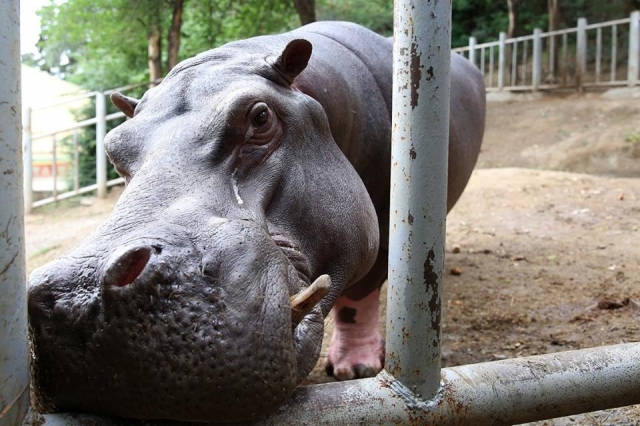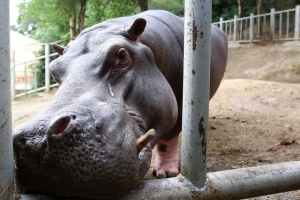A Year on From the Tbilisi Zoo Disaster and Dozens of Questions Still Remain
The image of Begi the hippo waddling through Tbilisi’s muddy streets with a puzzled expression on his face became an iconic image of the devastingly deadly floods that swept through the Georgian capital’s streets a year ago.
The June 13, 2015 disaster turned the international media’s attention to Georgia after the flood claimed 20 lives, caused millions of dollars in damage and nearly wiped out the Tbilisi Zoo.
A year on from the tragedy and it has become apparent that most of the damage could have been avoided if only Tbilisi’s city planners had been less reluctant to listen to those who opposed building a highway where the Vere River ultimately spilled over its banks with devastating consequences taking lives such as that of Guliko Nozadze, a much-beloved zoo caretaker, who with her husband and an elderly watchman, perished in the flood as they worked to release dozens of animals trapped in their cages.
Days after the flood, as the shock of the devastation set in, panic spread throughout Tbilisi as word came that an escaped tiger had attacked and killed a man. The incident happened almost immediately after both the government and zoo authorities assured Tbilisi’s residents that all of the animals that were still loose had been either captured or eliminated.
Outraged, the public demanded an explanation as to how a tiger could still be on the loose after the authorities had guaranteed that all threats to the local population had been eliminated.
According to the zoo’s director, Zurab Gurielidze, the surviving animals had been counted and zoo officials discovered that a single tiger was still missing. They quickly concluded that the unaccounted for big cat had perished and was washed away in the flood.
The government, however, refused to take responsibility for the mistake and promptly took Gurielidze in for questioning. He was later released without any charges being brought against him.
Many unanswered questions still remain regarding the unethical behavior of dozens of law enforcement agents who decided to play the role of national hero by shooting and killing many of the zoo’s most beloved animals who could have otherwise been neutralized by professional handlers.
This is the most likely what led to the death of beloved lion cub Shumba, who was shot and killed by a police officer before anyone could ascertain whether or not the cub was dangerous.
Tbilisi Zoo’s inhabitants were not the only animal victims of the flood as the country’s largest dog shelter, founded by businessman Tamaz Elizbarashvili, was completely washed away with most of the dogs still in their kennels.
In the year since the flood, Georgia’s civil society has become emboldened due to the incompetence of the government and city authorities. Immediately after the tragedy, hundreds of young volunteers worked diligently to clear away the debris that clogged the river in the aftermath of the events of June 13.
Many in Georgia still blame the government for their inexcusable handling of the rescue operations and immediate clean-up as a result of the flood. Only footballer-turned-minister Kakha Kaladze recieved a nationwide thumbs-up as he took to the streets to help with the relief effort. A photo of mud-spattered Kaladze sitting wearily among debris, garbage, and splintered trees instantly went viral.
In the wake of the disaster at the zoo, city officials decided to relocate the city’s new zoo to a safer locale outside the city center near the Tbilisi Sea reservoir. Most originally interpreted the decision as being one that was meant to safeguard against a similar tragedy being repeated in the future. However, it now appears that the zoo’s future remains up in the air as dozens of local businessmen squabble over the future site.
Construction has not yet begun and the zoo will be operating at its current location for at least the next three years, according to its administration.
Most outside observers now wonder what the status of the Tbilisi Zoo is today. The partially rebuilt site reopened its gates on September 13, 2015, three months after the flood. At the time, visitors were surprised by the condition of the renovated upper half of the zoo. However, the lower part was completely destroyed by the flood and remains closed to this day.
The area now has new apartments, grass, roads and trees that reveal no trace of the disaster that occurred in the city a year ago.
Tbilisi Zoo is currently home to an albino lion family and the main attraction, Begi the hippo, who is oblivious to his own superstardom. He remains as cheerful as ever no matter how many visitors he receives. Fortunately, the zoo still retains the majority of its winged inhabitants, as well as diverse non-predatory fauna.
22 new animals from European Zoos have been donated, including wildebeests, mongoose and a charming yet gruff group of porcupines which have quickly become crowd favorites.
Tbilisi Zoo, though almost halved in size, remains open for business as it awaits word on its fate in the coming year.
Vazha Tabveridze
Photo: Tbilisi City Hall












